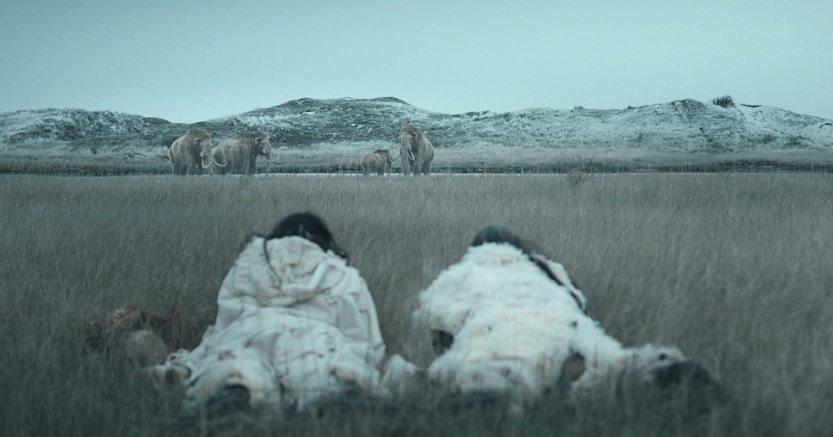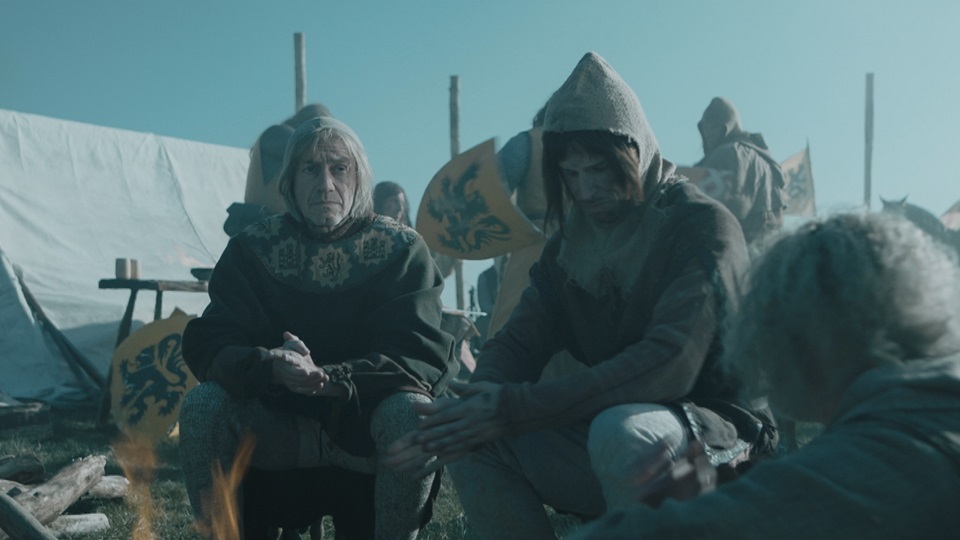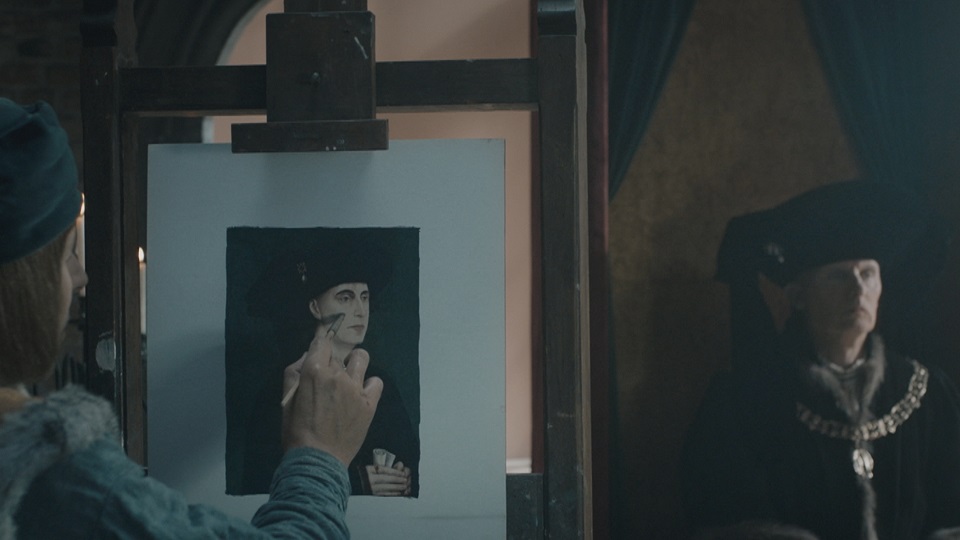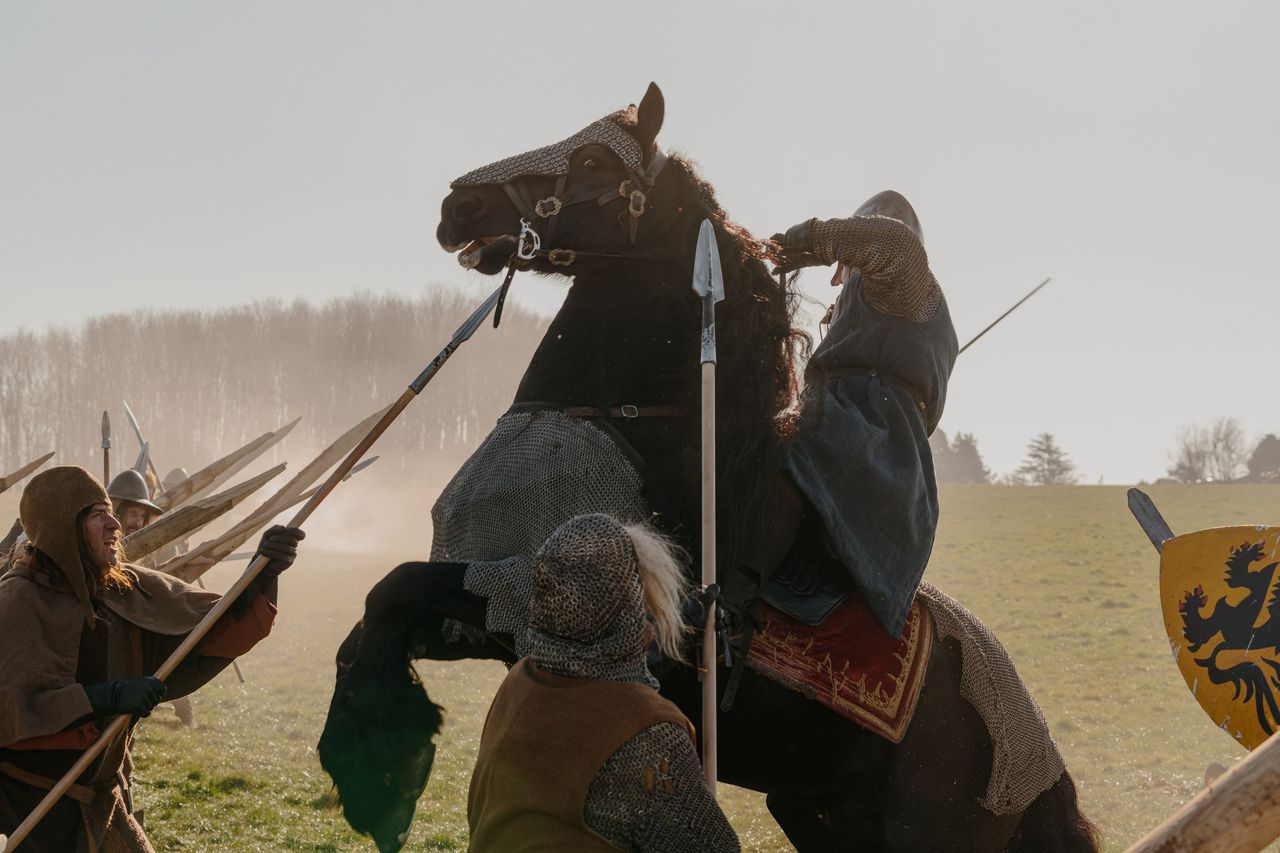Too expensive. Too Flemish. Too dumb. Everyone in Flanders has a different opinion on the TV series Het Verhaal van Vlaanderen. But no one can deny it was a ratings hit.
It was the most successful Flemish TV series in decades. And it didn’t involve reality stars. It was a ten-part history series called Het Verhaal van Vlaanderen, or The Story of Flanders. Boring, you might think. Yet more than one million people sat down to watch the first episode. Not bad for a region described in the series as a "scrap of ground measuring just 14,000 square kilometres."
Other small countries had already done something similar. The original concept came from Denmark where the epic series Historien om Danmark, presented by Scandi drama star Lars Mikkelsen, was screened in 2017. The series had a cool Nordic Noir look thanks to stylish title sequences and graphic reconstructions by designer Uffe Raupach. It was a new way of doing TV history.
The Dutch followed in 2022 with Het Verhaal van Nederland. Based closely on the Danish format, it was narrated by actor Daan Schuurmans. The Flemish production company De Mensen believed they could do something similar. Ten hours of television to cover 38,000 years of Flanders history.
It was an ambitious project for a small region. Two and a half years of research, followed by three years in production. The filming took place in 100 locations using 700 historical costumes from 37 epochs. Some 200 historians, guides and arms experts were involved. There were Vikings and mammoths, dukes and peasants, steam trains and trenches.
All this obviously required a serious budget. The Flemish government was approached for funding. Minister-president Jan Jambon of the Flemish nationalist party N-VA liked the idea. It fitted with the party’s aim of teaching the Flemish to cherish their unique identity.
Jambon dug around in various cultural funds to put together a package. He took €400,000 from the education budget, €300,000 from the Flanders Image fund, €250,000 from tourism, €150,000 from culture, along with bits and pieces from other sources. It added up to €2.4 million. Hardly big bucks for an epic series (the 2022 war movie All Quiet on the Western Front recently cost Netflix €20 million). But enough money to cause a fuss.
History or propaganda?
The controversy heated up long before the first episode was broadcast. The opposition parties were particularly vocal in their criticism. Hannelore Goeman of the socialist Vooruit party complained that the government could find money for Flemish propaganda but not for schoolbooks, childcare, or school meals.
Many prominent historians refused to work on the series, suggesting it was not so much history as nationalist propaganda. But Raf Uten, CEO and creative director of De Mensen, argued there was no political interference. "The government didn’t see a single line of the script," he insisted.
After the first episode came out on January 1, some of the criticism died away. People liked the format with its mix of stunning re-enactments and expert talking heads. Exactly what the national broadcaster VRT was meant to do. Looking at the viewing figures per head of population, the Flemish series scored even better than its Dutch or Danish predecessors.

Imagined scene during the stone age
The only jarring note for some was the presenter Tom Waes, who is famous in Flanders for his travel programme Reizen Waes (Travels with Waes). He took on his new role as a time traveller to step into historical re-enactments with his familiar cheeky gags delivered in a thick Antwerp accent. It was in-your-face TV compared to modest Lars Mikkelsen.
The first episode kicked off in a quiet suburban street somewhere in Limburg. Tom Waes stepped out of his SUV, put on his rubber boots, and began with a weary, "So…History." Then the scene shifted to 36,000 BC, and Waes standing in the middle of the palaeolithic wilderness. "Shit, man, it was bloody cold in prehistory," he announced, like a history teacher hoping for a laugh.
In later episodes, the viewer learned about the Romans, the Battle of the Golden Spurs, the religious wars, the Industrial Revolution and the two World Wars. Historian Jelle Haemers, who teaches mediaeval history at Leuven University, argued the series wrongly treated history as a succession of battles. But that was not really true. The budget, although generous, only allowed for two full-scale battle scenes: Romans against the Belgae and the Battle of the Golden Spurs of 1302.

The Roman era
By the third episode, it was impossible to claim the series was Flemish propaganda. The historian Jan Dumolyn explained that the Battle of the Golden Spurs was not a Flemish independence struggle, but a class struggle between poor weavers and powerful aristocrats. "The Flemish were the Taliban of the era," he added. Bart De Wever, the Flemish nationalist leader, was not amused.

Before the battle of the Golden Spurs
Nor were some of the critics. They complained that the Battle of the Golden Spurs took up an entire episode. Too much for one battle. Especially when a later episode fast-forwarded through 60 years of history, from the Fall of Antwerp in 1585 to the Peace of Westphalia of 1648, ignoring William of Orange, Charles V, Pieter Paul Rubens, and the invention of printing. As if they had done a history of Italy without mentioning the Renaissance. "The Story of Flanders is only half of the story," concluded De Standaard.
Drama in dry facts
Yet it made for gripping television for a winter evening. The programme-makers had come up with some striking ways of presenting the dry facts of history. In the episode on the Industrial Revolution, Tom Waes demonstrated the cramped living conditions in a notorious Ghent slum by marking out a grid on a local football pitch with each small rectangle representing a home. He then hammered home the appalling living conditions by marshalling 585 volunteers into the white rectangles.
Even a visit to the stuffy National Archives in Brussels made for exciting television. Tom Waes was shown a vast collection of bulging 16th-century ledgers that recorded the everyday terror of the Spanish Inquisition. Every heresy trial was documented down to the smallest detail.
Some critics complained that women were left out of the story. But the episode on the Industrial Revolution introduced the forgotten feminist campaigner Emilie Claeys, who had campaigned unsuccessfully for women’s votes more than 50 years before they were finally granted in 1948. Not long after the episode was aired, Ghent city council voted to put up a plaque in memory of Claeys.
The series was clearly having an impact. People were going to museums and historical sites they had seen on TV. Following an episode featuring Onze-Lieve-Vrouw church in Bruges, visitors flocked to look at the tomb of Mary of Burgundy and Charles the Bold. The Archaeocentrum in Velzeke and the Gallo-Roman Museum in Tongeren also noticed a spike in visitor numbers.

Philip the Good's portrait is painted
When it came to the Belgian Revolution of 1830, the producers faced a tricky problem. It was the beginning of the story of Belgium. A French-speaking country with its industry and wealth concentrated in Wallonia. But that at least made it easier to confront the atrocities in Congo, which could be blamed on Belgium and the King of the Belgians. Nothing to do with the Flemish.
One of the most impressive moments in the series was a reconstruction of the ‘human zoo’ at the 1897 World's Fair, when Congolese people were brought to Tervuren to pose in a fake village surrounded by a fence. The programme-makers carefully reconstructed the setting based on a single black-and-white photograph. The scene caught the moment when a woman turns away from the camera, refusing to be treated as a spectacle.
Some historians were still unhappy. The series got things wrong. Or missed things out. "It ignores Limburg," one historian complained. "I hope it is never used in schools," said another.
The Danish and Dutch series also had their critics. Danish viewers complained that the series had a left-wing bias and was soft on Communism.
Maybe there should be a warning at the beginning. A message to the viewer that this is just one way of telling the story. The Historien om Danmark talks about the Vikings in one way. The Flemish series offers a different way of looking at the Norse invaders. In Het Verhaal van Vlaanderen, the Fall of Antwerp is presented as a catastrophe that plunged the region into crisis, as merchants and intellectuals fled north to Amsterdam. But the same event, seen through Dutch eyes, marked the beginning of the Dutch Golden Age.
Tom's story
The final episode of Het Verhaal van Vlaanderen was largely the story of one person. The viewer saw the period from 1939 to 2000 as it affected Tom Waes. You saw his father proudly at the wheel of his first car. His parents at the coast. Tom revisiting his school in Antwerp, where he was kept back a year for setting off a fire alarm in the gym.
He also, to be fair, touched on some serious topics. The war was discussed in all its grim detail, including Flemish collaborators, civilians accidentally killed by American bombers, Breendonk concentration camp.
And the script didn’t shy away from migration. Waes explained that the migrants were needed to work in the mines and the steelworks, doing dirty and dangerous jobs. The men’s families were persuaded to join them because it suited employers. Many didn’t learn the language because they were on temporary ‘guest worker’ contracts.
But something important was missing from that final episode. Tom Waes didn’t once mention the language struggle that erupted in the 1960s and eventually led to the split of Belgium into three regions. If anything has shaped Flemish identity over the past 38,000 years, it is the struggle for equal rights for Dutch speakers.
The last episode concluded with a sketch of modern Flanders. It was, we were told, a mixed and varied society. Tom Waes made the point by posing for a selfie with a group of young people from diverse backgrounds. Some women were wearing headscarves. "The idea of Flemish, of native Flemish, no longer exists," declared the migration expert Achmed Zizaoui.
This was something of a bombshell. After all, the series had originally been seen as a way of shaping Flemish identity. A propaganda exercise, according to its harshest critics. Yet it ended by saying that the Flemish didn’t exist. So that was €2.4 million of Flemish government money down the drain. "Not the government’s version of Flemish history," ran a headline in De Standaard.
The point was hammered home further by a montage of familiar images from the turn of the 20th century. You saw the fall of the Berlin Wall, Obama’s "Yes We Can" speech, the Twin Towers, Putin. But not one image of Flanders. That "scrap of ground measuring just 14,400 square kilometres" appeared to have vanished from history.
In the final scene, it was back to Waes, celebrating New Year’s Eve with his friends. Gelukkig nieuwjaar – Happy New Year, he signs off with his trademark cheeky smile, leaving the viewer with the uneasy impression that they had just sat through ten episodes of Het Verhaal van Tom Waes.
The ten episodes of Het Verhaal van Vlaanderen are available to watch on VRT Max. The Dutch series Het Verhaal van Nederland is on NPO start, and the Danish series Historien om Danmark can be found on dr.dk.


